
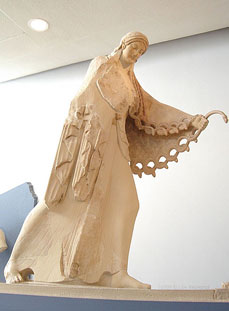
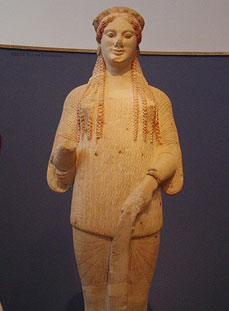
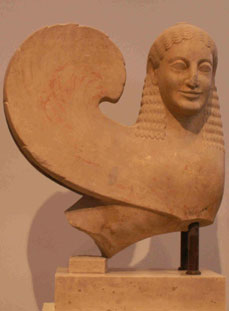
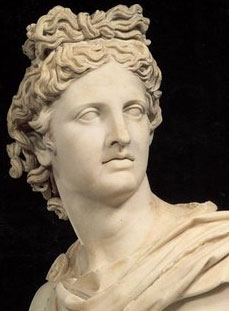
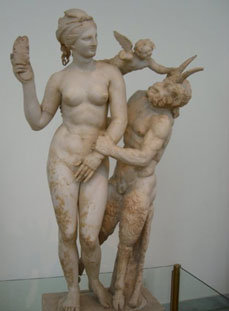
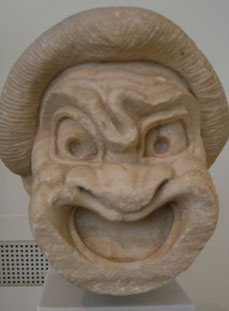
History of the Acropolis
Archaeologists have found evidence that Athens has been inhabited from at least the fifth millennium BC. The site would have been attractive to early settlers for a number of reasons: its closeness to the coast and the natural safe harbour of Piraeus; the existence of defensible high ground, the Acropolis (from akron and polis, or city on the high ground); and the proximity of a natural source of water on the north-west side of the Acropolis.
Traces of Mycenaean fortifications from the thirteenth century BC can still be seen on the Acropolis, including some foundations belonging to what must have been a palatial structure. The fortifications, known as the Pelasgian walls (after the indigenous people believed to have built them before the arrival of the Greeks around 2000 BC), remained in use until the Persian Wars of 490-480 BC. One stretch behind the temple of Athena Nike appears to have been deliberately preserved in the Classical period.
There was a decline of Mycenaean society across the Greek world around the end of the twelfth century BC. Whether this was directly connected with the Trojan War (around 1184 BC), of the so-called Dorian Invasion thought to have taken place soon after the conflict, Athens does not appear to have succumbed to an attack. The Mycenaean royal family of Pylos is said to have taken refuge in Athens after their city’s fall to the Dorians. One of its members, Codros, became king of his adoptive city.
The collapse of Mycenaean civilization left Greece in political, economic and social decline, accompanied by loss of artistic skills, literacy and trade networks. The Mycenaean form of writing, known as Linear B, was completely forgotten, an the Greek alphabet did not emerge until the late eight century BC as the new form of writing. At this time city states began to emerge throughout the Greek world, governed by oligarchies, or aristocratic councils. Thirteen kings ruled in Athens after Codros, until in 753 BC they were replaced by officials with a ten-year term, known as decennial archons, and in 683 BC by annually appointed eponymous archons.
Conflict between the oligarchs and the lower classes, many of whom had been reduced to slavery, led to a series of reforms that paved the way for the emergence of the world’s first true democracy. Around 620 BC the lawmaker Dracon set up wooden tablets on the Acropolis known as axones. These were inscribed with civil laws and punishments so harsh that the death penalty was prescribed even for minor crimes, giving rise to the term ‘draconian’ which is still used today. Dracon’s intervention did little to ensure order, prompting representatives of the nobles and lower classes in 594 BC to appoint the statement and poet Solon as archon.
Solon terminated aristocratic rule, setting up a representational government where participation was determined not by lineage or bloodline, but wealth. He eliminated slavery based on debt, and restituted freedom and land to those who had been enslaved. Solon created a Council of Four Hundred from equal numbers of representatives of the Ionian tribes to which the Athenians claimed to belong, and instituted four classes of citizenry.
Peisistratos, Solon’s youngest cosin, became tyrant (tyrannos) of Athens in 545 BC. He ensured the Solonian constitution was respected and governed benevolently. After Peisistratos’ death, however, things took a negative turn and anti-Peisistratid sentiment grew. By 510 BC King Cleomenes of Sparta was asked to assist in deposing Peisistratos’ son Hippias. Hippias sought refuge in Persia at the court of King Darius.
Soon after, the aristocrat Cleisthenes promised to institute further reforms giving a more direct role to citizens in government. His reforms were passed in 508 BC, and democracy was established in Athens. A new Council of Five Hundred (the Boule) replaced the Council of Four Hundred, with equal representation from various tribes. Cleisthenes is also credited with instituting the system of ostracism, which voted an individual considered dangerous to democracy into exile for ten years.
It is uncertain when the former Mycenaean citadel was transformed into a sacred precinct but by the late eight century BC a modest temple (perhaps more than one) stood on the plateau. The oldest and holiest cult image on the Acropolis was the statue of Athena Polias (Protectress of the City), a crude olive-wood figure, so old that Athenians of the Classical period believed it had either fallen from heaven or been made by Cecrops or Erichthonios. This sacred image of Athena was ritually dressed every year in a peplos, a sacred robe, as part of the Panathenaic festival.
A temple is thought to have been built around 700 BC to the south of the later, Classical Erechtheion, to house the statue of Athena Polias. The first major building of which there are significant remains on the Acropolis was the so-called Bluebeard Temple is thought by some to have stood to the south of the later Erechtheion. Ancient texts mention a mysterious building or precinct contemporary to the Bluebeard Temple, called the Hecatompedon, or ‘Hundred-footer’. Whatever this structure or place was, it gave its name to the principal room of the Classical Parthenon, perhaps because the later building occupies the same site.
With the expulsion of Hippias a new temple was built on the Acropolis, its foundations still visible to the south of the later Erechtheion. This building, the Archaios Naos, or ancient temple, is likely to have been deliberately commissioned around 506 BC as a replacement for the Bluebeard Temple.
The first Persian invasion of 490 BC saw the victory of the Athenians at the battle of Marathon against the forces of King Darius of Persia. The following year the elated Athenians leveled an area on the south side of the Acropolis and began construction of the Old Parthenon. A new gateway to the Acropolis was also commenced, known as the Old Propylaia.
This post-Marathonian building program on the Acropolis came to a violent end in 480 BC in Xerxes, son of King Darius, led a second invasion of Greece. Athens had to be evacuated and Xerxes razed the city and buildings on the Acropolis. Under the command of Themistocles, the Athenians destroyed the Persian fleet of Salamis. Victory over the Persians was ensured after the battle of Plataea (479 BC), to the northwest of Athens, when the combined Greek army annihilated the Persians.
In the aftermath of the battle of Plataea, a vow was made by the victors never to rebuild the shrines that were destroyed in the war, preserving them instead as memorials for later generations.
Pericles, who was a general and statesman, came to power in Athens around 461 BC. He considered the oath of Plataea to have been fulfilled, as thirty years had elapsed from Persian invasion, and proceeded to reconstruct the temples on the Acropolis. He gathered together the best architects and artists in the city and plans were drawn up to erect new buildings that would outshine those torn down by the Persians. The Periclean building program enhanced the lower city with new monuments, such as the Temple of Hephaestus, and the Painted Stoa or Poikile situated near the Agora (market place).
Mythology
The ancient Athenians considered themselves to be autochthonous, or indigenous people, claiming descent from the mythical first kings Cecrops and Cranaos. Cecrops, said to have been born on the earth with a serpent – like lower body, witnessed the famous contest between the deities Athena and Poseidon for patronage of the city. The god Poseidon claimed Athens by thrusting his trident into the middle of the Acropolis and producing a pool of salt water. Athena, instead, planted an olive tree at a spot to the west of Erechtheion and this was judged by Cecrops to be the best gift.
The half – serpent Athenian ancestor and younger contemporary of Cecrops, Erichthonios, was born from the semen of the god Hephaestos, as it fell to earth during his attempt to violate Athena. She subsequently undertook to raise Erichthonios and when he came of age he replaced Cecrops as king of Athens. Erichthonios was thought to have erected the first cult statue of Athena on the Acropolis and instituted the annual Panathenaic festival. According to Homer, Athena installed Erichthonios’ grandson, Erectheus, in a temple dedicated to herself on the Acropolis, from which he later ruled Athens.
The legebd of Theseus, his birth and ascent to the throne of Athens is one of the most important in Athenian mythology. Son of King Aegeus, he was a linear descendant o Erectheus. On a visit to the city of Troezen, Aegeus took king Pittheus’s daughter Aethra to bed and later, from this encounter she bore him a child, Theseus. When he came of age, Theseus made his way to Athens taking with him sandals and a sword which would act as tokens by which Aegeus would recognize him as his son. After successfully defeating a number of dangerous brigands at the Isthmus if Corinth, Theseus, attended a banquet given by his father. Fearing him as a contender to the throne, Aegeus attempted to poison Theseus, but on seeing the sandals and sword realized his mistake and dashed the poisoned cup from his son’s hands and embraced him as his successor.
Theseus was famous for slaying the half-bull, half-human creature, the Minotaur, that resided in the Cretan Labyrinth. King Minos of Crete had invaded Attica and Athens had agreed to pay tribute to him every year by sending seven youths and seven maidens to be devoured by the Minotaur. Theseus offered to go as one of the sacrificial youths in an attempt to slay the Minotaur. He told his father, Aegeus, that he would change the black sails of his ship to white if he succeeded. In Crete, Minos’ daughter Ariadne advised Theseus to tie the end of a thread to the entrance of the Labyrinth so he could retrace his path back from the centre of the maze. Theseus succeeded in killing the Minotaur but forgot to change his ship’s sails when returning to Athens. Spying his son’s black-sailed ship, Aegeus in despair hurled himself into the sea, which has been known ever since as the Aegean.
Theseus made a number of political reforms. Most importantly, he is said to have created the synoikismos of Attica, unifying the tribal settlements and turning them into a single political entity centred on Athens. According to Plutarch, Theseus was responsible for establishing the Panathenaic festival, giving Athens its name, and reinstating the Isthmian Games.
